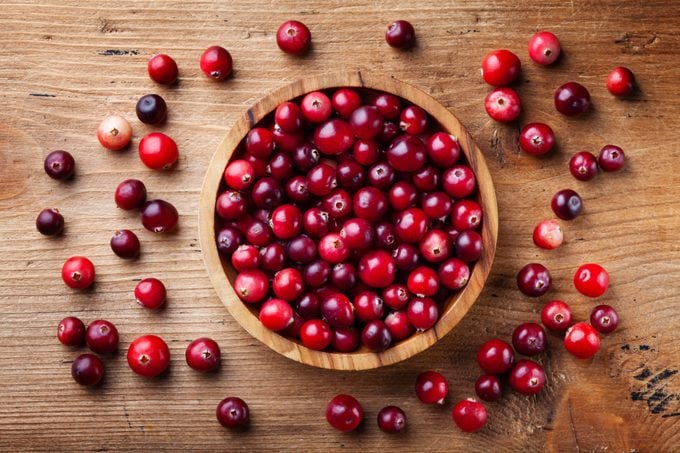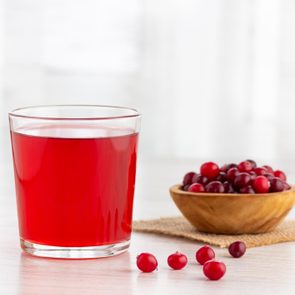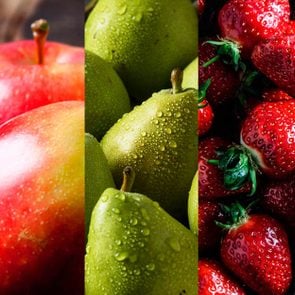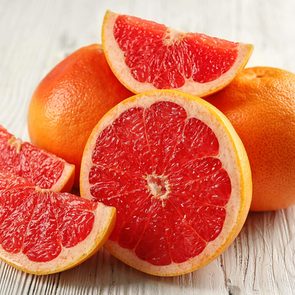Should You Eat Cranberries? The Benefits, Nutrition, and More
Updated: Mar. 16, 2022
With promises of lots of nutrients and antioxidants, there are plenty of reasons cranberries should be a year-round treat.
A year-round healthy choice
They’re round, red, and oh-so tart. But unless it’s Thanksgiving (or you need a home remedy for a UTI), you might not think much about cranberries. Strawberries, blueberries, raspberries—these are the go-to berries. But cranberries deserve a look, too. They’re incredibly nutritious and deliver some surprising health benefits.
Americans eat nearly 400 million pounds of cranberries each year, according to a 2019 report by the Agricultural Marketing Resource Center. Each person in the United States eats about 2.3 pounds of cranberries annually, but most of that is in the form of juice or juice blends. By comparison, Americans eat more than double—about 4.85 pounds—of strawberries per person each year.
What is a cranberry?
Vaccinium macrocarpon is the official name of the cranberry. The fruit grows on vines in bogs from April to November in the Northern U.S., including New Jersey, Massachusetts, Oregon, Washington, and Wisconsin, according to the Cape Cod Cranberry Growers Association. They’re also grown in parts of Canada. A smaller type of cranberry—known as the English mossberry—is grown in Europe. Fun fact: Cranberry vines can survive for more than 100 years.
Cranberry nutrition facts
There are several ways you can eat cranberries, including fresh, dried, and cooked into sauce. Fresh cranberries are higher in nutrients like fiber, potassium, and key vitamins; dried are much higher in calories and sugar. But not everyone likes the bracingly tart taste of these fresh berries. Here’s a look at cranberry health benefits and notable nutrients for both fresh and dried versions—note that the serving size is significantly higher for fresh than dried:
For one cup of fresh cranberries:
- Calories: 46
- Fiber: 4 grams (g): That’s 14% of your daily needs (Daily Value, or DV)
- Protein: 0 g
- Carbohydrates: 12 g
- Sugars: 4 g
- Potassium: 80 milligrams (mg)
- Vitamin C: 16 mg: 23% DV
- Vitamin E: 1 mg
- Vitamin K: 5 micrograms (mcg)
For 1/4 cup of dried cranberries:
- Calories: 123
- Fiber: 2 g
- Protein: 0 g
- Carbohydrate: 33 g
- Sugars: 29 g
- Potassium: 20 mg
- Vitamin C: 0 mg
- Vitamin E: 0.5 mg
- Vitamin K: 3 mcg

Cranberry health benefits
There are a lot of reasons why cranberries are healthy. “Cranberries are a good source of vitamin C, as well as phenols and proanthocyanins, antioxidants that have been shown to be cancer preventative as well as gut- and heart-healthy,” says Robin Foroutan, RDN, an integrative and functional nutrition expert in New York City and spokesperson for the Academy of Nutrition and Dietetics.
Cranberries and UTIs
These proanthocyanins are one reason cranberries have a reputation for fighting urinary tract infections (UTIs). In fact, consuming cranberry products was found to reduce the rate of UTIs by up to 33 percent, particularly in people who are at risk for developing these infections, according to a review of studies published in 2017 in the Journal of Urology.
Cranberries and your stomach
These proanthocyanins also may stop the bacteria Helicobacter pylori (H. pylori) from sticking to the stomach lining. H. pylori is responsible for some stomach cancers and ulcers.
Cranberries and your heart
Cranberries—particularly in juice form—have been found to have heart benefits. Some studies have found that cranberry juices and supplements may lower LDL cholesterol and lower blood pressure and other risk factors for heart disease.
Cranberries may be beneficial for metabolic syndrome
Fresh cranberries are also very low in calories. One cup has just 46 calories. And thanks to their tart taste, you’re unlikely to overeat them. Beyond that, though, cranberries have anti-inflammatory properties that could be helpful for people with metabolic syndrome. Eating them on a regular basis, suggests a review of studies in the Journal of Functional Foods, may help improve insulin function and blood lipid levels.
One thing to remember: Dried cranberries have far more calories than fresh. Each tablespoon has about 30 calories, so—depending on your health goals—you may want to stay mindful of portions. That’s especially true if you’re consuming cranberries that have added sugar.
Cranberries and your immunity
Fresh cranberries are also a good source of vitamin C—a cup of fresh berries offers a fifth of what you need for the day. Vitamin C plays a key role in immunity, research in the journal Nutrients shows. To maximize C, choose fresh cranberries over dried versions.
Are there any concerns or risks with eating cranberries?
Cranberries contain moderately high levels of substances called oxalates, says Foroutan. If you’re prone to kidney stones, consuming high amounts of oxalates may increase your risk of developing them. That depends on how much you consume, of course. But if you’re actively limiting oxalates in your diet, keep an eye on cranberry intake. (Find out if cranberry juice is good for kidney stones.)
How to eat cranberries
“Cranberries are a wonderful food, but they’re very tart and often come in products that have a lot of added sugar,” says Ginger Hultin, RD, spokesperson for the Academy of Nutrition and Dietetics and owner of Champagne Nutrition. Here’s how to maximize your nutrition when you eat them:
Fresh cranberries
Here’s a little cranberry-consuming secret: You can eat them raw. “Keep a bag of raw cranberries in the fridge,” suggests Foroutan. “They can be tart and bitter, but tart and bitter isn’t always bad. Our palate has gravitated toward the idea of all food being sweet. But these are flavor profiles that are good, too.”
Another perk for fresh? Research shows that fresh cranberries have higher anthocyanin antioxidant content compared to dried, according to research published in 2019 in the journal Food & Function.
Dried cranberries
Dried cranberries (aka “craisins”) are available with and without added sugar. Look for those with no added sugar.
Cranberry juice
Like craisins, cranberry juice is available with and without added sugar. Instead of cranberry juice cocktail, which has added sugar, look for 100 percent cranberry juice, advises Hultin.
Cranberry sauce
A Thanksgiving staple, cranberry sauce is made of fresh cranberries. Add orange peel while cranberries are cooking to boost vitamin C and antioxidants, suggests Foroutan. Another tip: Rather than use all the sugar a recipe may call for, add in a little at a time until you get just enough sweetness.
How to incorporate cranberries in your diet
There are so many ways to enjoy the flavors of cranberries—not just during the holiday season, but year-round. While there’s no general recommendation for how often you should eat cranberries, look at them as a way to add variety to your diet. A varied diet ensures you’re getting a wide range of good-for-your-body nutrients.
Here are some ideas:
- Toss dried cranberries into your salad.
- Use cranberry sauce as a spread on bread. (Try Hultin’s Naturally Sweetened Cranberry Sauce.)
- Cook into a relish to serve alongside meat.
- Add dried cranberries to a homemade trail mix or granola.
- Toss fresh cranberries into a smoothie.
- Add dried cranberries into a muffin, scone, or quick bread recipe. (Try this orange juice muffin recipe.)
- Mix dried cranberries into a tuna or chicken salad.
- Mix into homemade energy bars.






















